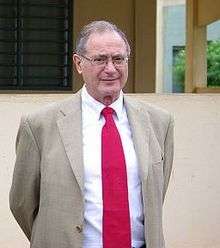Jean Serra
| Jean Serra | |
|---|---|
|
Jean Serra in 2007 | |
| Born |
1940 Algeria |
| Citizenship |
|
| Fields | Mathematics, geology |
| Institutions | Centre de Morphologie Mathématique, École des Mines de Paris |
| Known for | co-founding Mathematical morphology |
Jean Paul Frédéric Serra (born 1940 in Algeria) is a French mathematician and engineer, and known as one of the co-founders (together with Georges Matheron) of mathematical morphology.
Biography
Education
Serra received a scientific baccalauréat in 1957, and an engineering degree from the École Nationale Supérieure des Mines de Nancy in 1962. He also obtained a Bachelor degree in philosophy/psychology, from the University of Nancy, in 1965. He obtained a PhD in Mathematical Geology from the University of Nancy in 1967, and a doctorat d'etat in Mathematics, from the Pierre and Marie Curie University, Paris, in 1986. He speaks French, Russian, English, and Spanish.
Mathematical morphology
From 1962 to 1966, while a research engineer at the Institut de recherche de la sidérurgie, France, Serra was a PhD student under the supervision of Georges Matheron. The subject of his thesis was "stochastic modeling of the iron deposit of Lorraine, at various scales," one of the goals of which was to quantify petrographic characteristics of its iron orebody. During that period, Serra came up with the idea of using structuring elements for transforming images of cross sections of the ore, in order to gain information about it. The result was a device called "Texture Analyser", which was patented in 1965. This work also lead to the concept of hit-or-miss transform, which evolved into the concepts of erosion, dilation, opening and closing due to Matheron. Granulometry and other concepts followed. In the Winter of 1966, in a pub of Nancy,[1] Matheron, Philippe Formery, and Serra decided to give a name to this body of works: "Mathematical morphology". The new theory and method has since evolved to be applied in a variety of image processing problems and tasks, and is researched worldwide[2] (main article: Mathematical morphology).
In 1968, the Centre of Mathematical Morphology (CMM) of the École des Mines de Paris was created (after 1979, it was called Centre of Geostatistics and Mathematical Morphology). Matheron was named director, and Serra was hired as master of research ("Maître de Recherches") and assistant director. In 1986, upon the split of the Centre of Geostatistics and Mathematical Morphology into two separate centers, Serra became director of research ("Directeur de Recherches") and the director of the new CMM.
Serra has continued to contribute to mathematical morphology over the years; In fact, some of the most important theoretical developments are due to him:
- Generalization of mathematical morphology to complete lattices
- Theory for morphological filtering, with Matheron
- Connections
Additional highlights
- 1979–1983: Vice-president of the International Society for Stereology.
- 1983–: Member of the editorial board of Acta Stereologica.
- 1988–1991: Member of the scientific board of the French T.V. cultural program.
- 1989–: Member of the editorial board of the Journal of Visual Communication and Image Representation.
- 1990–: Member of the editorial board of the Journal of Mathematical Imaging and Vision.
- 1991–1993 : Chairman of the "Image Algebra and Morphological Processing Conference" in SPIE annual meeting, San Diego, California, USA.
- 1993: Chairman of the first Int. Conf. in Mathematical Morphology, Barcelona, Spain.[3]
- 1994: Chairman of the second Int. Conf. in Mathematical Morphology, Fontainebleau, France.[4]
Honors and awards
- 1982 : ESCLANGON prize, awarded by the French Society of Physics.
- 1988 : First award of the great prize of the AFCET Society.
- 1989 : Chevalier of the National Order of Merit.
- 1993 : Doctor Honoris Causa of the Autonomous University of Barcelona, Spain.
- 1993 : Founder of the International Society for Mathematical Morphology, and first president of this society.
- 2006 : First recipient of Georges Matheron Lectureship Award[5] of International Association for Mathematical Geosciences
Main Publications
- Image Analysis and Mathematical Morphology, ISBN 0-12-637240-3 (1982)
- Image Analysis and Mathematical Morphology, Volume 2: Theoretical Advances, ISBN 0-12-637241-1 (1988)
Notes
- ↑ "Appendix A: The 'centre de morphologie mathematique': An overview" by Jean Serra, in (Serra and Soille (Eds.) 1994).
- ↑ See, e.g., (Banon, Barrera, and Braga-Neto (Eds.) 2007)
- ↑ See (Serra and Salembier (Eds.) 1993)
- ↑ See (Serra and Soille (Eds.) 1994)
- ↑ "IAMG Newsletter No 73, Page 8;" (PDF). 2006-12-01. Retrieved 2014-08-25.
References
- Serra's curriculum vitae
- Serra's web page at the Centre de Morphologie Mathématique, École des Mines de Paris
- History of Mathematical Morphology, by Georges Matheron and Jean Serra
- Mathematical Morphology and its Application to Signal Processing, J. Serra and Ph. Salembier (Eds.), proceedings of the 1st international symposium on mathematical morphology (ISMM'93), ISBN 84-7653-271-7 (1993)
- Mathematical Morphology and Its Applications to Image Processing, J. Serra and P. Soille (Eds.), proceedings of the 2nd international symposium on mathematical morphology (ISMM'94), ISBN 0-7923-3093-5 (1994)
- Mathematical Morphology: 40 Years On, Christian Ronse, Laurent Najman, and Etienne Decencière (Eds.), ISBN 1-4020-3442-3 (2005)
- Mathematical Morphology and its Applications to Signal and Image Processing, Gerald J.F. Banon, Junior Barrera, Ulisses M. Braga-Neto (Eds.), proceedings of the 8th international symposium on mathematical morphology (ISMM'07), ISBN 978-85-17-00032-4 (2007)
- Special Issue on 'Spatial Information Retrieval, Analysis, Reasoning and Modelling, B. S. Daya Sagar and Jean Serra (Eds.), International Journal of Remote Sensing, v. 31, no. 22, p. 5747-6032 (2010)
- Special Issue on 'Filtering and Segmentation in Mathematical Morphology, Laurent Najman, Junior Barrera, B. S. Daya Sagar, Petros Maragos and Dan Schonfeld (Eds.), IEEE Journal of Selected Topics in Signal Processing, v. 6, no. 7, p. 737-886 (2012)
